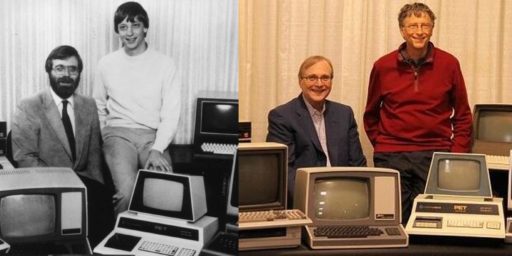Is Singularity Near?
Game theorist James Miller reviews a thought-provoking book by Ray Kurzweil entitled The Singularity Is Near today at Tech Central Station.
Most of us will become gods. And not one of those wimpy anthropomorphic gods from Greek myth, but gods trillions of times more intelligent than mere mortal men. Such is the thesis of Ray Kurzweil, who argues in The Singularity Is Near that humanity is inexorably headed towards the Singularity.
The singularity is a future period in which technological progress becomes so rapid that it radically transforms humankind. To picture the singularity imagine computers trillions of times smarter than Newton, Einstein and Edison inventing new technologies while continually enhancing their own abilities. Ray Kurzweil argues that the Singularity will occur around 2045.
Although godhood by 2045 seems like the conclusion of a lunatic, the genius of The Singularity is Near lies in showing that humanity already has tremendous technological momentum that almost has to carry us into the Singularity. And this momentum comes from the doubling every year of the power per dollar of information technology.
But the Singularity doesn’t appear near. This is because most of us are used to linear thinking and haven’t yet grasped the implications of the exponential growth of information technologies. For example, assume that the power of computers doubles every generation. Further assume that so far 100 generations have passed and our computers have but one-billionth of the power needed to achieve the Singularity. How many more doubling generations would be needed for humanity to reach this singularity? Well, linear thinking would say that since it took 100 generations to get one-billionth of the way there it will take a total of 100 billion generations to make it all the way. But if computer power doubles every generation, then it would take only 30 more generations for computer power to increase a billion fold.
The human brain is a much faster information processor than even the best of today’s computers. But the regular doubling of computing power means computers will quickly reach human equivalence. Kurzweil estimates this will happen by the early 2030s.
The ability to access and process information incredibly quickly is a great thing, to be sure, but the emergence of godlike intelligence would not necessarily follow. Indeed, it seems inordinately unlikely.
Still, Miller is likely right that, “The Singularity Is Near will be the most reviewed book in the Blogosphere this year. ” Fantastical ideas backed by solid research and analysis can be quite useful even if the predictions that follow are absurd. See all of Alvin Toffler’s books, for example.





What a pantload. There’s zero chance computing power will continue to double as quickly as it did in the past – we’re bumping up against problems of physics rather than of economics.
Kurzweil misses the big story: In spite of the incredible progress in improving speed and capacity of computers, artificial intelligence has remained elusive. That is a remarkable thing. It also completely undercuts his thesis.
Eh, Kurtweil is just a fast-talking book and vitamin salesman.
For a serious rebuttal to his and similar nonsense, read Jaron Lanier’s One Half a Manifesto (the continue link at the bottom of that page takes you to the essay). Brilliant stuff.
An old proverb in the technological forecasting world says that “Trees do not grow to the sky.” During the early stages of its life trees double in height in short periods of time. The growth rate, however, drops off as other physical limitations come into play.
One of the basic assumptions of technological forecasts is that present trends will continue. One of the realities is that present trends don’t continue indefinitely.
Kurzweil is getting press coverage. In 2045, his will be on the lists of mistaken forecasts.
The Bootstrapped-Brain Early Response Team’s task is to formulate a set of defensive protocols against potentially harmful activities of advanced artificial intelligence and the predicted “technological singularity” that may arise within the next 50 years.
Bootstrapped-Brain Early Warning Station
M1EK writes,
“What a pantload. There’s zero chance computing power will continue to double as quickly as it did in the past – we’re bumping up against problems of physics rather than of economics.”
Actually, we’re not even close to bumping up against problems of physics given the possibility of molecular manufacturing (i.e. advanced nanotechnology); a technology that has been well established as being physically possible.
Kent writes,
“In spite of the incredible progress in improving speed and capacity of computers, artificial intelligence has remained elusive. That is a remarkable thing. It also completely undercuts his thesis.”
How does this undercut his thesis? His thesis is that reverse engineering of the human brain will allow for the creation of artificial intelligence. And he predicts that the human brain will have been reverse engineered by around 2035 (if I’m not mistaken). Until we get closer to that time his thesis as it relates to artificial intelligence can’t really be evaluated.
Les Jones writes,
“For a serious rebuttal to his [Kurzweil’s] and similar nonsense, read Jaron Lanier’s One Half a Manifesto (the continue link at the bottom of that page takes you to the essay). Brilliant stuff.”
For a serious rebuttal to Jaron Lanier’s “One Half a Manifesto” see Kurzweil’s “One Half an Argument,” found here: http://www.kurzweilai.net/articles/art0236.html?printable=1
Herb Ely writes,
“One of the basic assumptions of technological forecasts is that present trends will continue. One of the realities is that present trends don’t continue indefinitely.”
The exponential trends that Kurzweil talks about are the historical rule rather than the exception, so it is deceptive to characterize them as simply “present” trends. While it is true that trends can change, it would be surprising to see exponential trends come to an end given that, as I said above, they are the rule rather than the exception. Please refer to Kurzweil’s “Law of Accelerating Returns” for an elaboration on this. That article can be found here: http://www.kurzweilai.net/articles/art0134.html?printable=1
P.S. For more information on Kurzweil’s ideas from Kurzweil himself visit kurzweilai.net